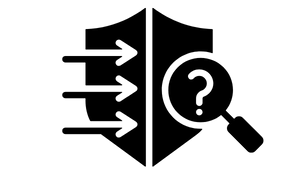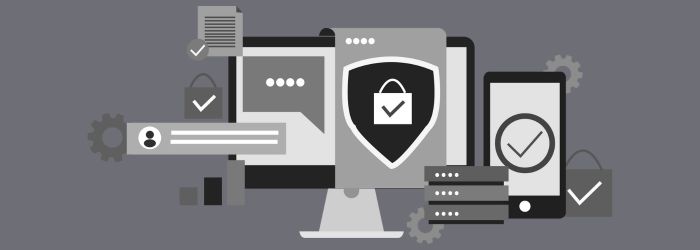Remote work has undeniably transformed how we operate, but it has also presented several challenges surrounding IT—the most pertinent being security. Ensuring organizational data security has become a paramount concern with teams dispersed across various locations and devices.
On average, a data breach costs organizations $3.86 million. Whether your employees are working from home permanently, returning to the office, or combining both, check out these questions posed by digital transformation consultants to determine what IT security solutions you may need to prevent threats.
Top 10 IT Security Challenges Questions for Optimal Solutions
1. Evolution of Security Plans: As organizations embrace new technologies and adapt to evolving business landscapes, how have their security plans evolved? Assessing whether security measures have kept pace with technological advancements and organizational changes is imperative. Are there adequate resources allocated to address emerging threats effectively? Understanding the evolution of security plans in tandem with technological investments provides insights into the organization's readiness to tackle modern cybersecurity challenges.
As the complexities of your environment change, how have your security plans evolved with your technology investments?
2. Staying Ahead of Cyber Threats: The cybersecurity landscape is constantly changing, with cybercriminals employing increasingly sophisticated tactics to breach defenses. How is your organization staying ahead of these threats? Proactive measures such as threat intelligence gathering, security awareness training, and regular vulnerability assessments are essential for mitigating risks. By fostering a cybersecurity awareness and vigilance culture, organizations can empower their workforce to identify and respond to potential threats effectively.
What are you doing to stay ahead in the cybersecurity and threat landscape to ensure you are protected from evolving threats?
3. Compliance Obligations: Regulatory compliance is a non-negotiable aspect of modern business operations, particularly in industries handling sensitive data, such as healthcare and finance. Does your organization have compliance obligations to meet? Identifying relevant regulations and standards is the first step toward ensuring compliance. From GDPR to HIPAA, understanding the regulatory landscape enables organizations to implement measures that safeguard sensitive data and mitigate legal risks.
Do you have compliance obligations? If so, what are they?
4. Email and Endpoint Security: Email remains one of the most common vectors for cyber attacks, with phishing and malware-laden attachments posing significant threats. How does your organization address email and endpoint security? Deploying robust email filtering systems, implementing multi-factor authentication, and regularly updating endpoint protection software are essential to safeguard against email-borne threats. Additionally, educating employees about best email security practices can help mitigate the risk of phishing attacks.
Specifically, what are you doing for email and security endpoint protection, and how is it managed?
5. Cloud Security Strategy: With the widespread adoption of cloud services, securing cloud-based assets has become a top priority for organizations. What is your organization's cloud security strategy? From data encryption and access controls to continuous monitoring and threat detection, a comprehensive cloud security strategy encompasses various measures to protect sensitive data stored in the cloud. Additionally, ensuring compliance with industry-specific regulations and standards is paramount when leveraging data cloud services.
What is your cloud security strategy?
6. Incident Response Preparedness: No organization is immune to security incidents, making incident response preparedness a critical component of any cybersecurity strategy. How would your organization respond to a security incident or data breach? Establishing an incident response plan that outlines roles, responsibilities, and escalation procedures is essential for minimizing the impact of security incidents. Regularly conducting incident response drills and tabletop exercises can help identify gaps in the response plan and ensure readiness to handle security incidents effectively.
If you had an incident/emergency right now, would you know? How would you react to that? How much revenue lost/downtime can you tolerate in the event of an attack?
7. IT Staffing and Security Expertise: The effectiveness of cybersecurity measures often hinges on the expertise of IT personnel tasked with implementing and managing them. How many IT professionals does your organization employ, and do you have dedicated security personnel? From security analysts and network administrators to chief information security officers (CISOs), having a skilled IT team with specialized security expertise is essential for maintaining robust cybersecurity defenses. Additionally, organizations may opt to collaborate with trusted third-party security providers to augment their internal capabilities and gain access to specialized expertise.
How many people do you have in IT, and more specifically, do you have a dedicated security engineer on staff, or do you work with a trusted third-party risk and assessment advisor?
8. Awareness of IT Security Technology Shifts: In the fast-paced world of cybersecurity, staying abreast of technological advancements is crucial for maintaining a competitive edge. Are you aware of the latest security technologies that could enhance your organization's defenses? Emerging technologies offer innovative solutions to combat evolving cyber threats, from artificial intelligence and machine learning-powered threat detection to blockchain-based authentication mechanisms. By staying informed about technological trends and developments, organizations can proactively adapt their security strategies to stay ahead of cybercriminals.
Have you heard about the shift in security technology that will strengthen your current security model?
9. Interest in Security Technology Shifts: Embracing emerging security technologies can significantly enhance an organization's cybersecurity posture. Would your organization want to explore how these technologies can strengthen its security defenses? Whether attending industry conferences, participating in webinars, or engaging with cybersecurity vendors, organizations have numerous opportunities to learn about innovative security technologies. By fostering a culture of innovation and experimentation, organizations can identify and deploy technologies that offer the greatest value in mitigating cybersecurity risks.
Would you be interested in hearing about the shift in IT security technology and how it can strengthen your security model?
10. Audit and Testing Frequency: Regular audits and testing are essential for evaluating the effectiveness of security measures and identifying potential vulnerabilities. When did your organization last undergo a comprehensive security audit or penetration test? Conducting periodic audits and assessments enables organizations to identify weaknesses in their security posture and take corrective action before they can be exploited by cybercriminals. Additionally, partnering with trusted third-party security firms can validate security controls independently and help organizations stay ahead of emerging threats.
When was the last time you were audited or tested, and would you be open for aligned partners with you on this?
Securing a remote workforce in today's digital landscape requires a multi-faceted approach encompassing technology, processes, and people. In addition to addressing the key considerations mentioned above, organizations may also benefit from exploring cybersecurity as a service (CSaaS) solutions. CSaaS providers offer a range of services, from threat detection and incident response to security monitoring and compliance management. By leveraging CSaaS offerings, organizations can augment their internal cybersecurity capabilities, gain access to specialized expertise, and stay ahead of evolving cyber threats.
CSaaS solutions provide flexibility and scalability, allowing organizations to tailor their cybersecurity strategy to meet their needs and budget constraints. Whether it's outsourcing routine security tasks or accessing advanced threat intelligence capabilities, CSaaS providers offer a suite of services designed to bolster cybersecurity defenses effectively.
.png?width=700&height=127&name=Blue%20Mantis%20formerly%20known%20as%20SME%20Solutions%20Group%2c%20Inc.%20(GREEN).png)





